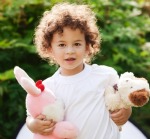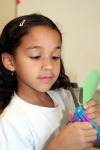Connect With Kids
If you find it difficult to connect with kids, yet you enjoy children and just need some tips on interacting with them, you've found the right place.
A child who rushes to the door may be easier to engage with than one who runs upstairs to hide. This is a guide on child behavior and interests to help you determine a good angle in which to "become friends" with the children you babysit. Child care is a challenging task, but being able to connect with kids is the first step toward a successful sitting engagement.

Babies (1 and under)
Usually not walking; watch for them to put anything into their mouths; typically love to be held, sung or hummed to; don’t feed them anything except bottles and baby food (no Cheerios, chocolate, etc.). Little ones (newborns) can’t hold their heads up yet. Never leave alone. Check for wet diapers; know where changing table, diapers and wipes are; have a burping cloth handy. Baby Einstein, some Sesame Street. Good child care for babies dictates heightened patience, love and attention. Follow the parents' rules to the tee. If the baby is too young, it may not matter if you quickly connect, because the child hasn't reached the stage of missing his mom or dad. As well, any child care professional will tell you that once babies reach the age that they DO miss their parents, attempts to connect may turn into simply attempts to keep them from crying.

Two-year-olds
Typical child behavior for this age: walking but usually not potty-trained; eating lots of people food but in small bites! Speaking some words, not quite able to make decipherable sentences. Love hearing/singing songs, peek-a-boo, and reading. Early twos still somewhat clumsy on their feet--watch around stairs, etc. Boys: trains, trucks, balls, dinosaurs, interactive toys. Girls: dolls and doll houses, shapes, stuffed animals. Both: crayons and paper; books; little cars they use their feet to power; building blocks; bath time! Not ready for board games; nothing with tiny pieces. PBS Kids, Nick Jr., Disney. Quickly connect with two's by being on their level physically and playing how they play.
Three-and-four-year-olds
Pre-school. Either potty trained or close to it. Talking, enjoy dressing themselves; typically like to feel important and be helpful. Child behavior, if on the shy side may include drawing, reading, playing make-believe, or even playing alone. Girls: dress-up! Hair-dos, some starting soccer, gymnastics, dance. Dolls, swinging/playgrounds, art--they’ll let you know. Boys: being outside; sports; may already be into Wii; karate, etc. Usually quite active, energetic. PBS Kids, Nick Jr., Disney. Typical child behavior for this age may include tantrums and dramatics. Enhance quality of child care and quickly connect with kids by incorporating hand-motion songs to entertain children and help run down energy.

Five-and-six-year-olds
Child behavior at the pre-school or first grade level: children often talk a lot, can be difficult for them to get the whole story out! Fun making stuff in the kitchen, “science experiments,” reading, outside activities. Boys: Legos, sports, video games and online games (in moderation), scientific stuff, animals and facts, reading, creating stuff (art, building toys). Girls: sports, putting on fashion shows, make-believe, making up games, video games and online/computer games. (Monitor always). A great way to quickly connect with this age group is through books. They are just beginning to read, yet still enjoy being read to.
Seven-and-eight-year-olds
End of first grade, beginning of second. Typical child behavior for this age: precocious, quite literal-minded; learning math, history, reading, science, etc. Big imaginations; like to be creative, many like to perform. Sports, “best friends,” Wii, X-Box, other video games; computer games (always monitor); some already have an entrepreneurial spirit and want to do lemonade stands, etc. Ask them about where they’ve been--travel. Girls: dance, soccer, gymnastics, theater. Watch for cattiness. Girls like for you to be a part of their play/entertainment. Boys: sports, some already into skateboarding, riding bikes, “gadget”-type toys, less interested in having you right around them. Quickly connect with kids in this age group by being inventive, engaging in their ideas, and encouraging creativity.

Nine-and-ten-year-olds
Third grade, beginning of fourth. They have “crushes” that they may or may not (probably won’t) share with you. An important note on child behavior for this group is not to underestimate their intelligence and savviness. They hear/learn lots from older brothers and sisters and other kids at school. Boys: X-box, Wii, video/computer games; sports, many enjoy roughhousing; musical instruments; music in general. Having friends over, going to friends’ houses, sleepovers. Making forts. Girls: jewelry, clothes, “clubs,” sports, dance, cheerleading. Online games, making things (crafts, jewelry, buttons, magnets, etc.). Connect with kids in this age group with a good amount of energy--check the Babysitting Activities page for more ideas on how to connect with kids in this age group.

Eleven-and-twelve-year-olds
Fourth and fifth grade. Know about the birds and the bees. Typically know about Santa and the Easter Bunny (but make no assumptions). Child behavior for girls: braces, boys, some (fifth grade) dabbling with make-up, bras, shopping. Some still enjoy board games, TV, making stuff in the kitchen, talking, talking, talking. Want to seem grown-up; still into sports, dance, cheerleading or other hobbies/interests; fashion. Boys: still boys. Sports, roughhousing, video games, etc. Not as into girls as girls are into boys (though a crush may exist). To connect with kids in this age group, remember that they still enjoy building things, reading, music, being outdoors. Key for successful child care in this age group is not to try too hard. Boys may be easier to connect with than girls at this point. Quality child care for them can be as simple as being "all-time pitcher" for their baseball game!
Thirteen and older
More than likely you’ll only be providing child behavior for this age group on overnight stays or long periods of time when the parents are gone. You’ll be given a schedule of all the kids’ activities and will be told whether or not they can have friends over, go to someone else’s house, or order in food. The chances that they want to sit around with you are slim. If they do, girls tend to be interested in boys, their friends, Facebook, TV and sounding “cool.” Child behavior for boys is an interest in sports (including professional and college sports), girls, their friends, not talking to you at all if they can help it, and school-related stuff. (Games, clubs, etc.) Best of luck! Think of it less as an opportunity to connect with kids and more as being there when the child/pre-teen needs you for a meal or a ride. You may be able to quickly connect with kids in this age group through TV, movies, his/her activities, or even while eating meals. Typical child behavior for this age may include SNEAKINESS. Make sure you know what the rules really are, in regard to internet, phone/texting time, Facebook, etc.
There are no hard, fast rules on how to connect with kids, but like anything, this aspect of good child care requires patience, practice and dedication.
From Here to Home Connect With Kids
Babysitting Tips




